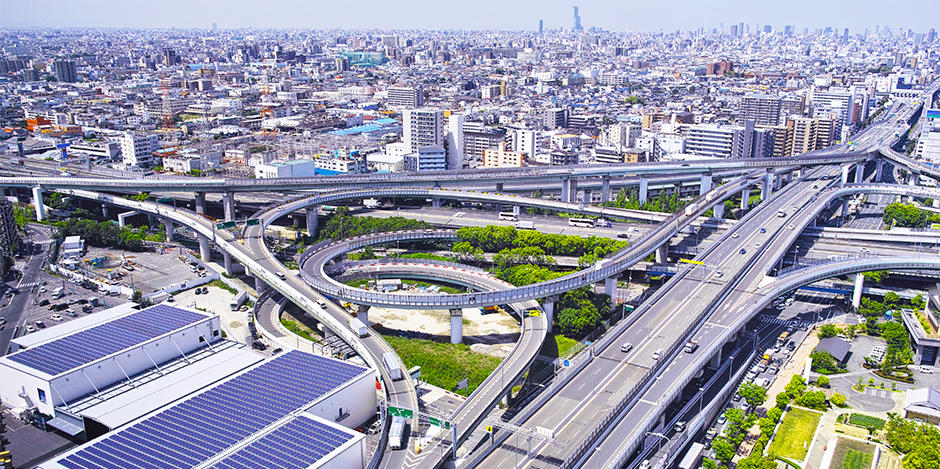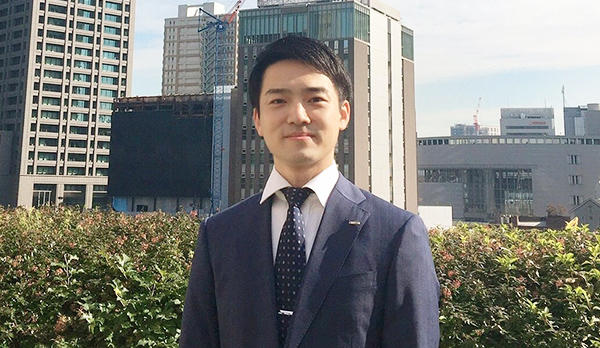
Many sections of the expressways, the nation's main artery and critical infrastructure, are more than 50 years old, and their road surfaces and structures are deteriorating. Its maintenance is important to ensure that expressways can continue to be used safely, securely and comfortably, but also one of the causes of accelerated road deterioration is heavy vehicles due to overloading needed to be solved. The Hanshin Expressway is working on to tackle this issue by developing and introducing a new weight measurement system using sensing technology in collaboration with OMRON SOCIAL SOLUTIONS Co.,Ltd. (OSS).
Do you know where was the first expressway built in Japan? It was the Meishin Expressway, which opened in July 1963. It still runs from the Ritto Interchange in Shiga Prefecture to the Amagasaki Interchange in Hyogo Prefecture, a distance of 71.7 km. The expressway network has been developed since the era of rapid economic growth and has supported our daily lives as a means of transportation for more than 50 years.
Today, however, this massive social infrastructure is facing the challenge of aging. 60% of the Hanshin Expressway, which opened in 1964, are now more than 40 years old it is imperative to take measures to ensure safety on the road.
We live in a society where expressways realizes faster movement speed of people and goods , and their benefits are immeasurable. The Hanshin Expressway and OSS are working together to introduce new technologies to confronting expressways deterioration in Japan , which are "roads that should never be stopped", and keep them in the best condition possible.
One of the reasons for these efforts is that expressways are becoming more important than ever as they are used for longer periods of time. Since expressways also serve as emergency roads in times of disaster, and in recent years, the incidents of extreme weather caused by global warming, and medium to large earthquakes are happening often, there has been an urgent need to ensure a stable driving environment for expressways, including seismic measures.
The Hanshin Expressway, in particular, is under extremely harsh conditions, with hundreds of thousands of vehicles using it daily, and the number of large vehicles is about six times higher than the roads in Osaka prefecture. In addition, bridges and other multi-story structures account for more than 90% of all roads, and damage such as cracks in concrete, corrosion and fatigue cracks of steel structures have become apparent.
Adding to this state of affairs are "overweight vehicles" that do not comply with the legal load weight. For example, a single trip on the road by an offending vehicle with an axle weight of 20 tons is said to cause the same amount of damage as 4,000 trips of a vehicle with an axle weight of 10 tons. More than 90% of the accelerated deterioration of roads is caused by these offending vehicles.
In the past, all vehicles were stopped once at the toll booths so that they could be weighed accurately at a standstill. Nowadays, the widespread adoption of ETC (electronic toll collection) lead to increase the number of vehicles passing through tollbooths without stopping. This has led to an urgent need to introduce an automated policing system that can measure weights accurately and identify vehicles with a camera even while they are moving.
This is not to say that there has never been a system that detects a vehicle in motion and measures its weight. OSS also had such a technology called WIM (Weigh-In-Motion) system. Since its founding, OMRON has been using its Sensing & Control technology to promote the automation of traffic, including the development of Japan's first signal control system using vehicle detectors and traffic control system. The WIM System, developed as part of these efforts, uses vehicle detection sensors to detect the presence or absence of vehicles and, in conjunction with weight measurement sensors embedded in the road, collects and analyzes the weight and other information necessary to identify the offending vehicle. The system can be used without stopping the vehicle and has been used for more than 20 years in general national highways.
The Hanshin Expressway, which has been had their eyes on OSS technology, was investigating the possibility of using the WIM system on its expressways, but it ran into one problem: the WIM system consists of two sensor systems: a sensor that detects the vehicle and identifies the type of vehicle, and a sensor that measures the weight. Because the vehicle detection sensor detects the metal parts of the vehicle body, the system does not work properly on roads with a multi-level structure, such as highways, where metal is used extensively.
Most of the Hanshin Expressway is an elevated roadway with a lot of steel floor plates. This means that the WIM system's vehicle detection method cannot be applied and limited space for installing system has been a challenge.
Therefore, OSS has changed its idea and discontinued the use of conventional vehicle detection sensors. By devising a system to process the output signals of the sensor measuring weight, that weight-measuring sensor can be used as a substitute for detecting the entry and exit of a vehicle. Thus, the system structure has been simplified and evolved.
In other words, instead of adding more equipment to the system by adding a new function, OSS has adopted the subtractive concept of "combining two roles into one".
As a result of this bold thinking in response to the performance and challenges demanded by road companies in the harsh environment of highways, a new automated system for policing heavy vehicles was completed and the number of places where it can be installed was greatly expanded.
Shoki Matsunaga, Traffic Control System Business Department, Social Solutions Business Division of OSS, which was in charge of the development of the system, talks about his team's aspirations.
"We approached this project with a belief that we want to continue providing value to all users, workers, and residents who use Japan's road transportation in terms of safety, security, and comfort with the pride of having contributed to the road transport society for over 50 years. This resulted in realizing this system that allowed us to create the value from ground up to our customers and society in order to achieve our objectives.
Now that people are paying more attention to sustainable practices, society's demands have changed from "building new roads" to "how can we use the roads we have built for a long time?"
Our next goal is to make use of the statistical data obtained through this project so that we can analyze how much and where heavy vehicles are traveling. In the future, we hope to be able to link this data to the development of maintenance and repair plans, such as which parts of the expressway need to be inspected and which parts need to be prioritized for repairment. We would like to make further contributions to society by creating roads that can be used for a long time.

We are committed to protecting the safety, security and comfort of roads by accelerating the resolution of new social issues as the environment surrounding roads changes with the times.
OMRON's challenge to improve the sustainability of our roads in collaboration with road companies will continue in the future.